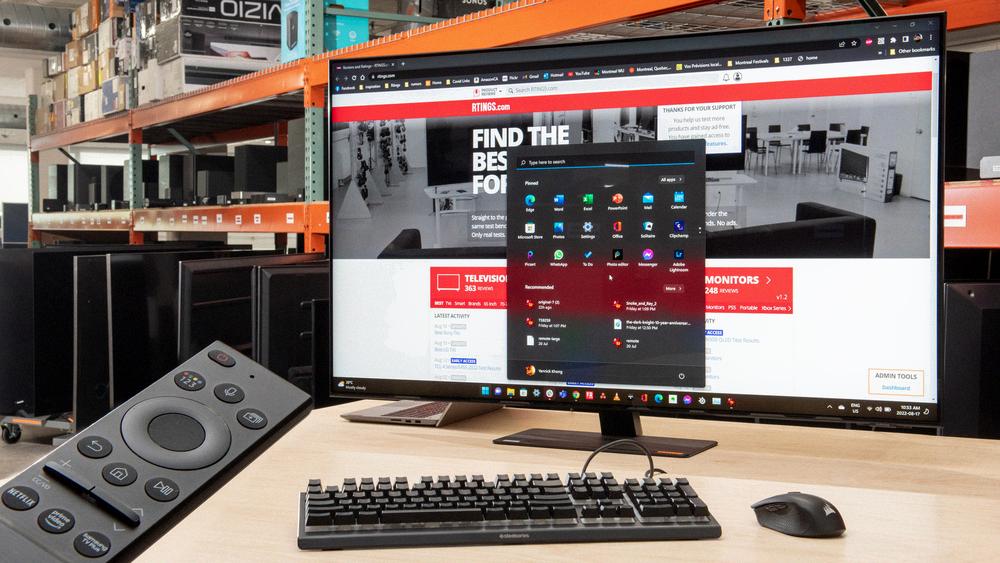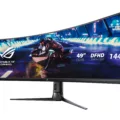4K TVs and 4K monitors have become increasingly popular in recent years due to their high resolution and crisp image quality. 4K resolution is four times the resolution of 1080p, making it an excellent option for those who want a clear and detailed display.
Using a 4K TV as a computer monitor can be an excellent option for those who want a larger display without spending a fortune on a 4K monitor. However, there are some things to consider before making the switch.
One of the most significant disadvantages of using a 4K TV as a computer monitor is lower DPI or dots per inch. This means that the text may appear blurry, making it difficult to read. While some TVs have a setting to adjust the DPI, this may not always be the case.
Another issue with using a 4K TV as a monitor is input lag. Input lag is the delay between the time a signal is sent from the computer to the time it appears on the screen. TVs tend to have higher input lag than monitors, which can be noticeable when using the computer for gaming or other applications that require quick response times.
Using a larger TV as a computer monitor can also be cumbersome, especially if you have limited desk space. TVs are also generally heavier than monitors, making them more difficult to move or adjust.
Despite these drawbacks, using a 4K TV as a computer monitor can be an excellent option for those who want a larger display without spending a lot of money. If you decide to go this route, be sure to choose a TV with a high refresh rate and low input lag to ensure the best possible experience.
While using a 4K TV as a computer monitor has its disadvantages, it can also be a great option for those who want a larger display without spending a fortune. Be sure to consider the DPI, input lag, and size of the TV before making the switch.

Is a 4K TV Better Than a Monitor?
When it comes to determining whether a 4K TV or a monitor is better, several factors come into play. Both devices offer 4K resolution, which means that they have a pixel density of 3840×2160. However, there are some key differences between the two that can affect their performance and suitability for different tasks.
One of the main differences between a 4K TV and a monitor is their size. TVs are generally larger than monitors, with some models being as large as 80 inches or more. Monitors, on the other hand, are typically smaller and range from 24 to 32 inches. This size difference can affect the viewing experience and the distance at which the screen should be viewed.
Another difference between the two is the input lag. Monitors generally have lower input lag than TVs, which makes them more suitable for gaming. Input lag refers to the delay between when a user inputs a command and when it is displayed on the screen. TVs typically have a higher input lag due to their processing capabilities, which can make them less responsive for gaming.
The refresh rate is another factor to consider. Monitors typically have a higher refresh rate than TVs, which means that they can display more frames per second. This can result in smoother motion and a better gaming experience. TVs typically have a refresh rate of 60 Hz, while monitors can have refresh rates of up to 240 Hz or more.
Response time can also differ between a 4K TV and a monitor. Response time refers to the time it takes for a pixel to change from one color to another. Monitors generally have lower response times, which means that they can display fast-moving images more clearly. TVs typically have a higher response time, which can result in motion blur in fast-moving scenes.
Whether a 4K TV or a monitor is better depends on your intended use. If you plan on using it primarily for gaming, a monitor may be a better choice due to its lower input lag, higher refresh rate, and faster response time. If you plan on using it for watching movies and TV shows, a 4K TV may be a better choice due to its larger size and more affordable price point.
Is Using a TV as a Computer Monitor Safe?
It is generally safe to use a TV as a computer monitor, as long as you take certain precautions. Here are some things to keep in mind:
1. Check for compatibility: Before connecting your TV to your computer, make sure that both devices are compatible. Check if your TV has an HDMI port and if your computer has an HDMI output. Also, check the resolution and refresh rate of your TV to make sure it can handle the output from your computer.
2. Adjust the settings: Once you have connected your TV to your computer, you may need to adjust the settings on both devices to get the best picture quality. You may need to adjust the resolution, refresh rate, and color settings on your computer to match the settings on your TV.
3. Use a proper cable: Make sure to use a high-quality HDMI cable to connect your TV to your computer. This will ensure that you get a clear and stable signal.
4. Be careful with your eyes: Using a TV as a computer monitor can be hard on your eyes, as TVs are designed for viewing from a distance. Make sure to adjust the distance between your eyes and the screen, as well as the brightness and contrast settings, to avoid eye strain.
5. Consider your work: Depending on what you plan to use your TV for, it may not be the best choice for a computer monitor. TVs are designed for watching movies and TV shows, which may not be suitable for tasks that require a lot of text or detail, such as editing documents or working with spreadsheets.
Using a TV as a computer monitor can be safe as long as you take the necessary precautions and make sure that both devices are compatible.
Disadvantages of Using a TV as a Monitor
There are several disadvantages to using a TV as a monitor for your computer. One of the most significant drawbacks is the lower DPI or dots per inch of a TV compared to a computer monitor. The lower DPI can result in text blurriness and reduced image clarity, which can lead to eye strain over time.
Another disadvantage is input lag, which can be a common issue when using a TV as a monitor. Input lag is the delay between when a signal is sent from the computer to the TV and when it is actually displayed on the screen. This delay can be frustrating, especially when playing games or doing tasks that require a quick response time.
Additionally, using a TV as a monitor can be cumbersome and inconvenient. TVs are usually larger and heavier than computer monitors, which can make them difficult to position and adjust. They may also require more space on your desk or in your room, which can be a problem if you have limited space available.
While using a TV as a monitor may seem like a convenient option, there are several disadvantages to consider, including lower DPI, input lag, and inconvenience. It is often better to invest in a high-quality computer monitor that is specifically designed to meet your needs as a computer user.
Conclusion
A 4K TV can be a great option for use as a computer monitor, but it does come with some potential drawbacks. While it may be more affordable and larger than a traditional computer monitor, it may have a lower DPI and higher input lag. It is important to consider your specific needs and preferences when deciding whether a 4K TV is right for you as a computer display. if you prioritize a larger display for watching movies and TV shows, as well as console gaming, a 4K TV may be the perfect choice for you. If you prioritize higher resolution and faster response time for gaming, a traditional computer monitor may be a better option.








